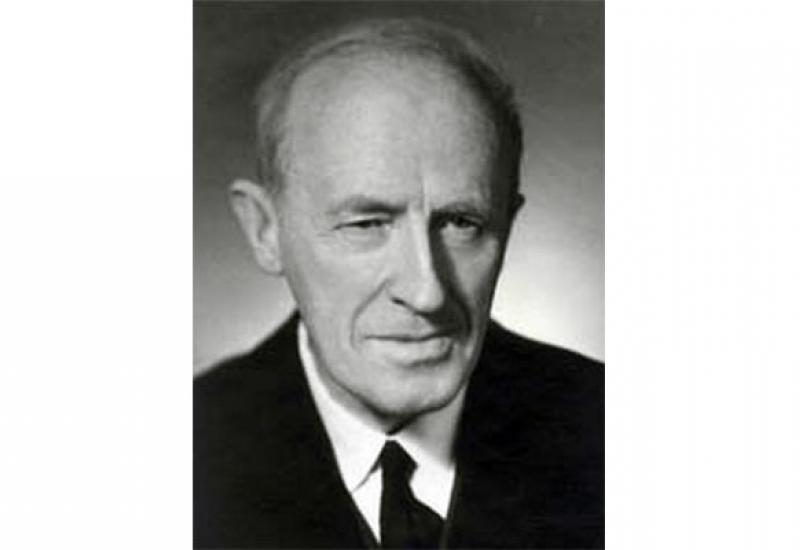Sergij Volodymyrovych Serensen was born in Khabarovsk in 1905. His father was an engineer. In 1926 he graduated from mechanical department of Kyjiv industrial institute (KPI) and in 1929 defended his thesis after postgraduate study. From 1928 till 1934 he worked as a senior staff scientist in building mechanics institute of USSR (Ukraine) Academy of Science, from 1934 till 1936 as a vice-director, from 1936 till 1940 as a director of this institute. Here S.V. Serensen organized conducting of integrated study of stability, shake, structural strength and also developed researches of constructional materials fatigue and bearing capacity of constructional elements during cyclic and impulsive load in aircraft building of engine and technological equipment, that has been developing since the first five-year plans.
In 1934 S.V. Serensen was elected to a corresponding member of USSR (Ukraine) Academy of Science, in 1936 he was awarded to a Doctor of Engineering, in 1938 to academic rank of professor, and in 1939, at the age of 34 years, he was elected to a member of Academy of Science in the field “Mechanics, strength in mechanical engineering”. From 1942 till 1967 S.V. Serensen had been organizing and doing researches of cyclic and thermal strength of air engine in P.I. Baranov CIAM. Since 1967 he stood at the head of a laboratory and thermal strength complex of mechanical engineering Institute of USSR (Ukraine) Academy of Science. At the same time he carried out pedagogic and organizational work in RSTI (Russian State Technological Institute), leading the department “Strength of materials”.
S.V. Serensen has a set of fundamental researches in the field of strength of materials and constructions, where a great attention is dedicated to their fatique. In the middle 30-s S.V. Serensen suggested gradient hypothesis of similarity of fatigue damage in heterogeneous stressed state zones, later developed by his followers in the form of probability conditions in stress concentration zones (V.P. Kogan, B.F. Balashov, M.N. Stepovyj, E.V. Giacyntov, T.P.Zaharova, L.V. Agarimov, P.S. Jevstratova, A.S. Serjogin, A.N. Lisin and others). A great contribution to science about strength was made by S.V. Serensen and his apprentices during new school development that was called low-cycle fatigue basis (R.M. Shnejderovich, A.P. Gusenko, N.A. Matuhov, P.I. Kotov, A.N. Pjetuhov and others). On the basis of experiment-calculated researches there was formed a deformative kinetic assessment criterion of damage storage and breaking initiation. It reflects the role of nonstationarity of cyclic deformation fields. Deformative kinetic interpretation crack development to critical state enabled scientists to calculate constructional elements liveness. These ideas were set as principles of researches of long-term strength, low-cycle fatigue during elevated temperature and thermal strength from the aspect of interference of arising damage from constant and cyclic deformation. Results of these researches are described through normative calculation methods of low-cycle strength of constructional elements of energetic and chemical reactors, welded construction and other goods. Within the limits of this school calculation methods were formed to determine the strength of such details as disks, steam and gas turbine blades and other vital parts of machines. This works, done by S.V. Serensen and his apprentices, influenced the development of study about the strength of composite materials (fiberglass plastic, organic plastic and details made from these materials). Statistical approach was applied during the research to assessment of fiber and array strength and explanation for mechanism of long-term static and cyclic damage of this class of materials. In consideration of this calculation methods for vital parts were elaborated (disks, propeller blades, compressor blades etc.) from polymer composite materials.
The main characteristic of Serensen school, that was developing during interaction of great scientific complexes, is the aspiration for using of gained fundamental results for elaboration of calculation methods for machine details and constructional elements strength in leading sectors of industry. They suggested calculation methods for strength of facilities in coal and metal industry, engineering structures and aircraft constructions, tractor elements and agricultural machinery, hydroturbines, high capacity presses, strength standarts of aircraft engines, equipment of nuclear energetic plants, machines and test benches for researches of characteristics of strength for materials of ultimate load-carrying capacity.
Academician S.V. Serensen was a member of National committee USSR (Soviet) of theoretical applied mechanics, National Committee USSR (Soviet) of welding and a member of Scientific Council USSR(Soviet) responsible for problems of “Scientific basis of strength and plasticity”. During many years he was a member of presidium RTS (Research and Technology Soviet) Ministry of mechanical engineering, where he worked on creating and developing up-to-date test numerical engineering in our country.
S.V. Serensen was an honourable doctor of many foreign universities. He was awarded a State prize USSR. For great contributions in mechanics development the scientist was awarded an Order of Lenin, two Orders of the Red Banner, Badge of Honour and medals.
Scientific heritage of this academician, which is in his scientific studies and works of his apprentices, is an invaluable base for further development in the direction, formed by him. Even now their actuality is confirmed in the field of scientific argument about resources and conditions of safe object operation in technosphere.
Researches with comprehensive programs were done in academic and sectoral institutes, design and technological offices of Russia, Ukraine, Byelorussia, Lithuania, Latvia, Kazakhstan, Czech Republic, Slovakia, Bulgaria. New scientific and practical elaborations of the problem of structural strength, founded by S.V. Serensen, were carried out.
Information resource: Scientific school of department “Mechanics of materials and constructions”.
Translated by Kravchenko Yuliia, LA-02

